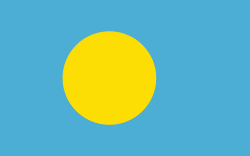Angaur (State of Angaur)
Angaur (アンガウル), or Ngeaur in Palauan, is an island and state in the island nation of Palau.
Angaur was traditionally divided among some eight clans. Traditional features within clan areas represent important symbols giving identity to families, clans and regions. These features include a variety of stone platforms with historical and traditional importance. Traditional cemeteries are frequently located in or around some of these stone platforms. The large quantities of shell recovered from archaeological sites gives evidence for an intensive exploitation of the limited lagoon surrounding the island and for collecting and fishing outside of the reef as well. On the island, the localized areas of soil were intensively used for garden plots.
The first sighting of Angaur, Babeldaob, Koror, and Peleliu recorded by Westerners was by the Spanish expedition of Ruy López de Villalobos at the end of January 1543. They were then charted as Los Arrecifes (The Reefs in Spanish). In November and December 1710, these three islands were again visited and explored by the Spanish missionary expedition commanded by Sargento Mayor Francisco Padilla on board of the patache Santísima Trinidad. Two years later they were explored in detail by the expedition of Spanish naval officer Bernardo de Egoy.
From 1909 until 1954 phosphate mining took place on Angaur, originally by the Germans, then the Japanese, and finally by Americans. Angaur is the site of a major World War II battle. The Battle of Angaur was part of the larger offensive campaign called Operation Forager that ran from June to Nov 1944. Many American and Japanese battle relics remain scattered throughout the island. The 7th Antiaircraft Artillery Battalion under Lieutenant colonel Henry R. Paige served as garrison forces for the remainder of the War. Angaur is the only place in Micronesia that has feral monkeys; they are descended from macaques that escaped during the period of German occupation. Thus it is also called Monkey Island.
Angaur is accessible by boats and small planes, and Belau Air has service to Angaur Airstrip. From 1945 to 1978 the U.S. Coast Guard operated a LORAN transmitting station, LORSTA Palau, as part of the worldwide LORAN navigation system.
Angaur was traditionally divided among some eight clans. Traditional features within clan areas represent important symbols giving identity to families, clans and regions. These features include a variety of stone platforms with historical and traditional importance. Traditional cemeteries are frequently located in or around some of these stone platforms. The large quantities of shell recovered from archaeological sites gives evidence for an intensive exploitation of the limited lagoon surrounding the island and for collecting and fishing outside of the reef as well. On the island, the localized areas of soil were intensively used for garden plots.
The first sighting of Angaur, Babeldaob, Koror, and Peleliu recorded by Westerners was by the Spanish expedition of Ruy López de Villalobos at the end of January 1543. They were then charted as Los Arrecifes (The Reefs in Spanish). In November and December 1710, these three islands were again visited and explored by the Spanish missionary expedition commanded by Sargento Mayor Francisco Padilla on board of the patache Santísima Trinidad. Two years later they were explored in detail by the expedition of Spanish naval officer Bernardo de Egoy.
From 1909 until 1954 phosphate mining took place on Angaur, originally by the Germans, then the Japanese, and finally by Americans. Angaur is the site of a major World War II battle. The Battle of Angaur was part of the larger offensive campaign called Operation Forager that ran from June to Nov 1944. Many American and Japanese battle relics remain scattered throughout the island. The 7th Antiaircraft Artillery Battalion under Lieutenant colonel Henry R. Paige served as garrison forces for the remainder of the War. Angaur is the only place in Micronesia that has feral monkeys; they are descended from macaques that escaped during the period of German occupation. Thus it is also called Monkey Island.
Angaur is accessible by boats and small planes, and Belau Air has service to Angaur Airstrip. From 1945 to 1978 the U.S. Coast Guard operated a LORAN transmitting station, LORSTA Palau, as part of the worldwide LORAN navigation system.
Map - Angaur (State of Angaur)
Map
Country - Palau
 |
 |
| Flag of Palau | |
The country was originally settled approximately 3,000 years ago by migrants from Maritime Southeast Asia. Palau was first drawn on a European map by the German missionary Paul Klein based on a description given by a group of Palauans shipwrecked on the Philippine coast on Samar. Palau islands were made part of the Spanish East Indies in 1885. Following Spain's defeat in the Spanish–American War in 1898, the islands were sold to Germany in 1899 under the terms of the German–Spanish Treaty, where they were administered as part of German New Guinea. After World War I, the islands were made a part of the Japanese-ruled South Seas Mandate by the League of Nations. During World War II, skirmishes, including the major Battle of Peleliu, were fought between American and Japanese troops as part of the Mariana and Palau Islands campaign. Along with other Pacific Islands, Palau was made a part of the United States-governed Trust Territory of the Pacific Islands in 1947. Having voted in a referendum against joining the Federated States of Micronesia in 1978, the islands gained full sovereignty in 1994 under a Compact of Free Association with the United States.
Currency / Language
| ISO | Currency | Symbol | Significant figures |
|---|---|---|---|
| USD | United States dollar | $ | 2 |
| ISO | Language |
|---|---|
| ZH | Chinese language |
| EN | English language |
| JA | Japanese language |
















